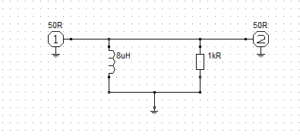This article documents measurement and analysis of a VK3AMP Sontheimer directional coupler in an implementation of a 400W wattmeter design by N2PK (Kiciack nd).
I purchased one of the couplers for use with a DIY digital display, and although I have had it longer, it isn’t yet realised!
A common failing of almost all hammy Sammy designs is appalling InsertionVSWR at the lower end of the specified frequency range. This coupler is specified for 1.8-54MHz, and differently to most, has meaningful published characteristics.
In this implementation, 60mm lengths of solder soaked braid coax similar to Succoform 141 were used between the PCB and box N connectors. The expected matched line loss of both of these is about 0.01dB @ 50MHz.
The measurements here were made by VK4MQ using an Agilent E5061A ENA, data analysis by myself.
Above are the raw s parameter measurements plotted. It is a full 2 port measurement, and it can be observed that the device is not perfectly symmetric, quite adequate, and quite good compared to other ham designs that I have measured. Continue reading Basic measurements of the VK3AMP Sontheimer directional coupler for a N2PK wattmeter





